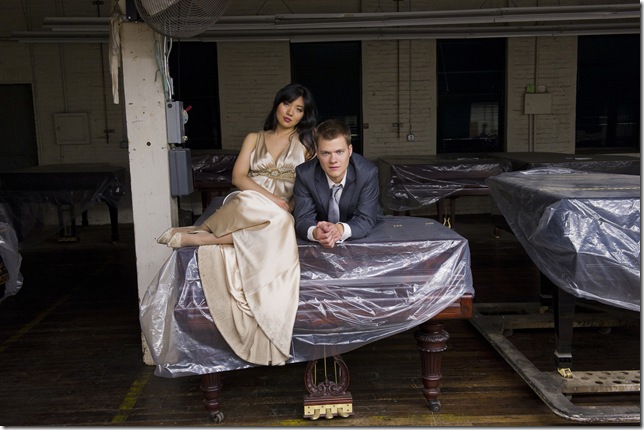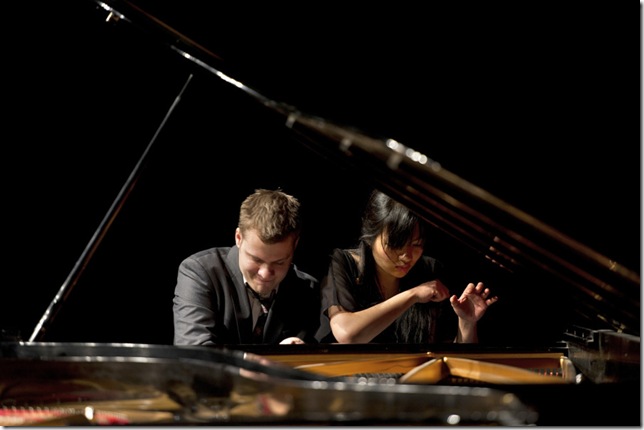You could look a long time and you’d be hard-pressed to find a whole lot of musical ensembles with a mission statement.
But Anderson and Roe, the two-piano sensation that formed at Juilliard a dozen years ago, have that staple of business culture right on the News page of their website:
“To make classical music a relevant and powerful force in society. To connect with others; to engage provoke, illuminate; to serve as a conduit for the composer’s voice; to express our inner lives; to share the joy and fulfillment that only music can elicit.”
And, of course: “To free the world from the constraints of sleep-inducing concerts.”
That mix of earnestness and frank irreverence is a hallmark of this brace of Midwesterners (he’s from St. Paul and she’s from Chicago) who met as piano phenoms as Juilliard freshmen back in 2000 and immediately discovered they had a similar approach to music to go along with their formidable musical abilities. Two years later, they gave their first duo concert, and since launching their career have established a reputation that embodies the spirit of today’s best young musicians: Brilliant players for whom genre erects no barriers, and whose enthusiastic performance style is as close to a rock band as you can get with a pair of acoustic Steinways.
“Both of us adore classical music, and music of many different genres and questions, and especially classical music. But we don’t always go to a concert and feel invigorated and alive afterward. As Liz can attest, I have been known to fall asleep in many concerts,” said Anderson, speaking along with Roe from Blacksburg, Va., earlier this month, where the two had just given a concert at Virginia Tech. “But when we present a performance or event, our primary concern is making sure that the music is relevant to our audiences. We don’t like to think of our concerts as a museum experience, where we admire and worship great works of art; instead we want the artworks to be a part of our lives and mean something unique to each and every one of us.”
Roe added: “We believe that the music is innately vital and compelling. We take so much joy in making the experience energetic and hopefully energizing for our audiences. And in general, I think one of the characteristics that defines our collaboration is that we take so much joy in the creative process. Just in our interaction, we spend so much time laughing, and having these crazy adventures.
“Not only is joy a mission in our art, it’s also a mission in our lives,” she said.
This Thursday, the two make a return appearance to South Florida for the fifth concert in the inaugural season of the Chamber Music Society of Palm Beach. The chief work on the program will be Igor Stravinsky’s The Rite of Spring, in the composer’s own four-hand version. It will be accompanied by the world premiere of a new piece of choreography by Christopher Huggins and Levi Marsman of the Alvin Ailey American Dance Theater that has been commissioned by the Chamber Music Society.
The dance will be performed by Marsman and students from the Dreyfoos School of the Arts.
Anderson said the choreographers have included the duo’s own “highly balletic” approach to the piece, in which their bodies are heavily involved in the performance, as they are with most of their performances. That includes not just motions at the keyboard such as elaborate hand crossovers, but also “convulsive” physical movements as they play the piece.
“It’s kind of a dream come true, actually, because we’ve been living with this piece for so long and we have such a close and intense relationship with it,” Roe said. “We know how closely associated it is with the body and with movement and with dance.
“The music itself elicits such a visceral response. Every time, we’re rendered breathless, and we’re so ecstatic as we play it. It’s incredible – the driving rhythms and the power of it. And to think we’re going to play it with all these bodies swirling around us; we just think it’s going to be incredibly exciting.”
Late last year, Anderson and Roe posted a 10-part series of wildly imaginative videos to accompany their performance of the Rite, culminating in the burning of an 1878 Clough & Warren antique organ in the shallows of the ocean at night. Roe said they didn’t want to imitate the original ballet scenario, which is set in ancient pagan Russia and involves the sacrifice of a virgin to the god of Spring.
“We thought that wouldn’t be as relevant to an audience in the 21st century,” she said. “But this is idea of sacrifice is an archetypal theme in life. What we thought would be resonant, and what we could really relate to, is this idea of sacrificing the materialism rampant in the world around us, and our artificial identities; the things that we associate ourselves with, and the positionalities that we take on.
“When you strip yourself of those things, you come to what’s at the very core of your being, or the core of your existence. We’re very inspired by the symbolism of the elements, the overwhelming power of nature that’s in Stravinsky’s score … it was the sound of the music that was the source of inspiration for our ideas.”
The duo also will play other four-hands, one-piano and two-piano works, including the Third Brandenburg Concerto (in G, BWV 1048) of J.S. Bach, as arranged by Max Reger; the Suite No. 1 for Two Pianos (Op. 5) of Sergei Rachmaninov; and three Anderson-and-Roe arrangements: Rimsky-Korsakov’s Flight of the Bumblebee; the Cat’s Fugue, based on a sonata by Domenico Scarlatti; and Ragtime Alla Turca, a reimagining of the Turkish Rondo from Mozart’s Piano Sonata No. 11 (in A, K. 331).
The arrangements the duo comes up with are an important part of what they do; they’ve written treatments of Astor Piazzolla’s Libertango as well as versions of pop tunes such as Michael Jackson’s Billie Jean, Radiohead’s Paranoid Android, and Coldplay’s Viva la Vida. Taking on a pop classic like Jackson’s 1982 smash and turning it into a workable piece for two pianists at one piano is more complex than simply running the music through the Liszt machine.
“Every piece, whether it be a pop piece or a classical piece that we arrange, we have to treat differently, and the piece almost dictates how we can go about it. In the case of ‘Billie Jean’ … it’s impossible to make it sound like Michael Jackson,” Anderson said. “And there’s no point to do it, if we want to make it sound like a pale approximation of Michael Jackson singing ‘Billie Jean.’ It’s just pointless.
“So we thought about it very differently, almost like a Picasso painting of a face, in which the face is all distorted and out of place and deconstructed. Picasso would do that because he was trying to bring out various physical characteristics of the face or because he was trying to bring out various aspects of the person’s personality. And we did that with ‘Billie Jean.’ We tried to tap into the sinister nature of the original song, and the lyrics, and certainly the music video; there’s something very dark and unsettling about that.”
The duo has released three recordings: Reimagine (2008), When Words Fade (2011), and late last month, An Amadeus Affair, an all-Mozart recording featuring, among other pieces, the Sonata for Two Pianos, Liszt’s paraphrase on themes from Don Giovanni, the Ragtime Alla Turca and an Anderson-and-Roe arrangement of Soave sia il vento, the farewell trio from Act I of Cosí fan Tutte.
Both pianists said the music of Mozart has been a lifelong passion, and Anderson added that as duo pianists, they’re able to take advantage of more of his work, especially in opera transcription, than a solo pianist would be able to do.
“We’re also fascinated by Mozart the man, who in addition to being this genius, seems like he must have been a fun guy to get to know,” Roe said. “You can tell that he was very sensitive, and aware of the human experience, and he channeled so many different facets of life so beautifully and naturally into his music. You have humor and drama and tragedy, you have refinement and mischief … Mozart is just eternally one of our favorites.”
Although their onstage chemistry is obvious to see and feel, the two pianists are not romantically involved. Anderson lives in Los Angeles with his husband, and Roe lives in Northern California.
Anderson and Roe’s current touring schedule takes them to Oregon and Michigan in the next few weeks, and then to South Korea and Taiwan in May. Mid-June finds them in the United Kingdom, followed by two recitals in Los Angeles.
Thursday’s concert in Palm Beach contains plenty of variety, and that’s important to the duo’s outlook.
“While we have the Rachmaninov Suite for Two Pianos on the program, which is one of our favorite works of all time, we also like to find things that we haven’t heard, and that our audiences likely haven’t heard,” Anderson said. “We like to keep people on their toes.”
Roe added that finding a good balance between the rare and the familiar helps keep the two musicians motivated, and on the road of an “endless journey.”
“We’ll always find new things in the music of Bach, but we’ll also find new things to arrange. It’s such a privilege to be a pianist, but especially a piano duo, because it is a bit of a tabula rasa genre. We feel like we’re free to explore new things and explore new territories.”
Anderson and Roe appear Thursday at Mar-a-Lago, Palm Beach. Cocktail reception at 6 p.m., concert at 7 p.m. Call 561-379-6773 or visit cmspb.org.

